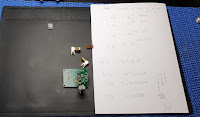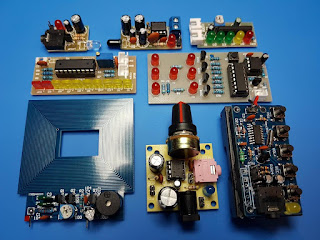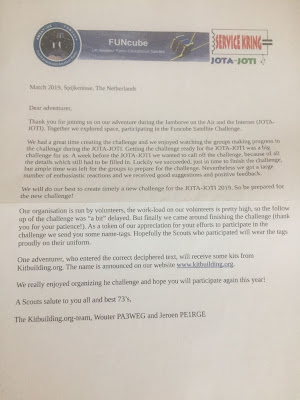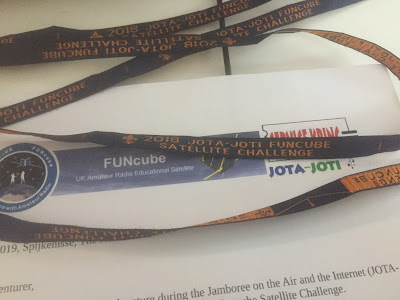Saturday 27 April 2019
Friday 26 April 2019
Jamboree on the air challenge *servicekring* Enigma Funcube decoding
Received a very nice letter today from Wouter PA3WEG and Jeroen PE1RGE, thanking us for participation in JOTA / JOTI Scout enigma challenge on the funcube 1 satellite.
They sent this letter and some very fancy badges for the Scouts to sew on their uniform
Great big thank you and looking forward to this years challenge!
"DEAR SCOUTS SPACE TRAVEL IS THE FUTURE GO ON A JOURNEY IN SPACE NOT ONLY DURING THE JOTA JOTI BUT THROUGHOUT THE YEAR RADIO AMATEURS CAN SUPPORT YOU HOPE TO MEET YOU IN THE FUTURE"
We got a couple of mentions on Amsat-UK web pages:
https://amsat-uk.org/2018/10/19/the-jota-joti-funcube-challenge/
and
https://amsat-uk.org/2018/10/22/scouts-participate-in-funcube-challenge/
http://kitbuilding.org/index.php?lang=nl
We (sixth staines scouts) got a mention on their web site.
They sent this letter and some very fancy badges for the Scouts to sew on their uniform
Great big thank you and looking forward to this years challenge!
The challenge was set to decode a message from FunCube1 satellite and then answer a set of questions to get the settings for the enigma decoding engine.
https://amsat-uk.org/2018/10/19/the-jota-joti-funcube-challenge/
We had some great fun setting this up and getting the full message eventually.
Thanks to all who helped set this up.
Here is our video of the fully decoded message
"DEAR SCOUTS SPACE TRAVEL IS THE FUTURE GO ON A JOURNEY IN SPACE NOT ONLY DURING THE JOTA JOTI BUT THROUGHOUT THE YEAR RADIO AMATEURS CAN SUPPORT YOU HOPE TO MEET YOU IN THE FUTURE"
We got a couple of mentions on Amsat-UK web pages:
https://amsat-uk.org/2018/10/19/the-jota-joti-funcube-challenge/
and
https://amsat-uk.org/2018/10/22/scouts-participate-in-funcube-challenge/
http://kitbuilding.org/index.php?lang=nl
We (sixth staines scouts) got a mention on their web site.
Monday 22 April 2019
Bias Tee virtual buildathon #vbuild is back
Chertsey Radio club
In association with
GazLab's
£12 Including postage
email jamesm0jfp@virginmedia.com
We will be running an evening session in the next few weeks and building the Bias-tee kit.
This simple kit helps supply 12 or 18 volts to the satellite dishes LNB, this in turn powers either the horizontal or vertical antenna amplifiers. The Narrow band (voice, CW, data) is Vertical, whilst the TV band is Horizontal. The kit contains 10 components (full size, no SMD!) and its estimated between 15 and 45 minutes to build and test the board.
We will be running the sessions using ZOOM platform and will share video and audio with the group. All videos of the build will be shared after the event on this site. You will need basic soldering kit, snips and at least a multimeter to run the electrical tests. To receive Es'hailsat 2 (QO-100) you will also need an old satellite dish and a reasonable LNB, available on ebay for about £12 including postage. The last thing you will need is a cheap SDR dongle, these can be easily purchased for about £15.
Setting up and pointing the dish, is a combination of fun and stress, but once you pick up the signal the satisfaction will overwhelm you.
To Register for your place please email jamesm0jfp@virginmedia.com




Part 1 of the build, check components, slight modifications and tweaks explained.
Part 2 inserting the components
Part 3 solder test and use (fin)
Some of our other successful virtual builds have included:
The Foxx-3



2/70 diplexer SMD kit



Pocket money projects by Bob M6FLT

Friday 19 April 2019
Special event Salyut-1 (DOS-1) First ever space station launched today 47 years ago
GB1DOS (Salyut-1)
Celebrating the very first space station 47 years ago today since the launch
Salyut 1 (DOS-1) (Russian: Салют-1) was the first space station of any kind, launched into low Earth orbit by the Soviet Union on April 19, 1971.
https://en.wikipedia.org/wiki/Salyut_1
Salyut 1 originated as a modification of the military Almaz space station program then in development.[2] After the landing of Apollo 11 on the Moon in July 1969, the Soviets began shifting the primary emphasis of their manned space program to orbiting space stations, with a possible lunar landing later in the 1970s if the N-1 booster became flight-worthy (it did not).[3] One other motivation for the space station program was a desire to one-up the US Skylab program then in development. The basic structure of Salyut 1 was adapted from the Almaz with a few modifications and would form the basis of all Soviet space stations through Mir.[2]
Salyut 1 originated as a modification of the military Almaz space station program then in development.[2] After the landing of Apollo 11 on the Moon in July 1969, the Soviets began shifting the primary emphasis of their manned space program to orbiting space stations, with a possible lunar landing later in the 1970s if the N-1 booster became flight-worthy (it did not).[3] One other motivation for the space station program was a desire to one-up the US Skylab program then in development. The basic structure of Salyut 1 was adapted from the Almaz with a few modifications and would form the basis of all Soviet space stations through Mir.[2]
Civilian Soviet space stations were internally referred to as DOS (the Russian acronym for "Long-duration orbital station"), although publicly, the Salyut name was used for the first six DOS stations (Mir was internally known as DOS-7).[2] Several military experiments were nonetheless carried on Salyut 1, including the OD-4 optical visual ranger,[4] the Orion ultraviolet instrument for characterizing rocket exhaust plumes,[5] and the highly classified Svinets radiometer.[6]
Construction and operational history
Construction of Salyut 1 began in early 1970, and after nearly a year it was shipped to the Baikonur Cosmodrome. Some remaining assembly work had yet to be done, and this was completed at the launch center. The Salyut programme was managed by Kerim Kerimov,[7] chairman of the state commission for Soyuz missions.[8]
Launch was planned for April 12, 1971 to coincide with the 10th anniversary of Yuri Gagarin's flight on Vostok 1, but technical problems delayed it until the 19th.[9] The first crew launched later in the Soyuz 10 mission, but they ran into troubles while docking and were unable to enter the station; the Soyuz 10 mission was aborted and the crew returned safely to Earth. A replacement crew launched in Soyuz 11 and remained on board for 23 days. This was the first time in the history of spaceflight that a space station had been manned, and a new record time was set in space. This success was, however, short-lived when the crew was killed during re-entry, as a pressure-equalization valve in the Soyuz 11 re-entry capsule had opened prematurely, causing the crew to asphyxiate. After this accident, all missions were suspended while the Soyuz spacecraft was redesigned. The station was intentionally destroyed by de-orbiting after six months in orbit, because it ran out of fuel before a redesigned Soyuz spacecraft could be launched to it.[10]
Structure
At launch, the announced purpose of Salyut was to test the elements of the systems of a space station and to conduct scientific research and experiments. The craft was described as being 20 m (66 ft) in length, 4 m (13 ft) in maximum diameter, and 99 m3 (3,500 cu ft) in interior space with an on-orbit dry mass of 18,425 kg (40,620 lb). Of its several compartments, three were pressurized (100 m³ total), and two could be entered by the crew.[1]
Transfer compartment
The transfer compartment was equipped with the only docking port of Salyut 1, which allowed one Soyuz 7K-OKS spacecraft to dock. It was the first use of the Soviet SSVP docking system that allowed internal crew transfer, a system that is in use today. The docking cone had a 2 m (6.6 ft) front diameter and a 3 m (9.8 ft) aft diameter.[1]
Main compartment
The second and main compartment was about 4 m (13 ft) in diameter. Televised views showed enough space for eight large chairs (seven at work consoles), several control panels, and 20 portholes (some obstructed by instruments).[1]
Auxiliary compartments
The third pressurized compartment contained the control and communications equipment, the power supply, the life support system, and other auxiliary equipment. The fourth and final unpressurized compartment was about 2 m in diameter and contained the engine installations and associated control equipment. Salyut had buffer chemical batteries, reserve supplies of oxygen and water, and regeneration systems. Externally mounted were two double sets of solar cell panels that extended like wings from the smaller compartments at each end, the heat regulation system's radiators, and orientation and control devices.[1]
Salyut 1 was modified from one of the Almaz airframes. The unpressurized service module was the modified service module of a Soyuz craft.[2]
Orion 1 Space Observatory
The astrophysical Orion 1 Space Observatory designed by Grigor Gurzadyan of Byurakan Observatory in Armenia, was installed in Salyut 1. Ultraviolet spectrograms of stars were obtained with the help of a mirror telescope of the Mersenne system and a spectrograph of the Wadsworth system using film sensitive to the far ultraviolet. The dispersion of the spectrograph was 32 Å/mm (3.2 nm/mm), while the resolution of the spectrograms derived was about 5 Å at 2600 Å (0.5 nm at 260 nm). Slitless spectrograms were obtained of the stars Vega and Beta Centauri between 2000 and 3800 Å (200 and 380 nm).[11] The telescope was operated by crew member Viktor Patsayev, who became the first man to operate a telescope outside the Earth's atmosphere.[12]
Soyuz 11
Soyuz 11 took 3 hours and 19 minutes on June 7 to complete docking.[14] The crew transferred to Salyut and their mission was announced as:[1]
- Checking the design, units, onboard systems, and equipment of the orbital piloted station
- Testing the station's manual and autonomous procedures for orientation and navigation, as well as the control systems for maneuvering the space complex in orbit
- Studying Earth's surface geology, geography, meteorology, and snow and ice cover
- Studying physical characteristics, processes, and phenomena in the atmosphere and outer space in various regions of the electromagnetic spectrum
- Conducting medico-biological studies to determine the feasibility of having cosmonauts in the station perform various tasks, and studying the influence of space flight on the human organism.
On June 29, after 23 days and flying 362 orbits, the mission was cut short due to problems aboard the station, including an electrical fire. The crew transferred back to Soyuz 11 and reentered the Earth's atmosphere. The capsule parachuted to a soft landing in Kazakhstan, but the recovery team opened the hatch to find all three crew members dead in their couches. An inquest found that a pressure relief valve had malfunctioned during re-entry leading to a loss of cabin atmosphere.[15] The crew were not wearing pressure suits, and it was decreed that all further Soyuz missions would require the use of them.[16]
| Expedition | Crew | Launch date | Flight up | Landing date | Flight down | Duration (days) | Notes |
|---|---|---|---|---|---|---|---|
| Soyuz 11 | Georgy Dobrovolsky, Viktor Patsayev, Vladislav Volkov | June 6, 1971, 07:55:09 UTC | Soyuz 11 | June 30, 1971, 02:16:52 UTC | Soyuz 11 | 23 days, 18 hours, 21 minutes, 43 seconds | Crew died on re-entry |
Re-entry
Salyut 1 was moved to a higher orbit in July–August 1971 to ensure that it would not be destroyed prematurely through orbital decay. In the meantime, Soyuz capsules were being substantially re-designed to allow pressure suits to be worn during launch, docking maneuvers, and re-entry.[17] The Soyuz redesign effort took too long however, and by September, Salyut 1 was running low on attitude control gas.[citation needed] It was decided to conclude the station's mission and on October 11, the main engines were fired for a deorbit maneuver. After 175 days, the world's first space station burned up over the Pacific Ocean.[1]
Pravda (October 26, 1971) reported that 75% of Salyut 1's studies were carried out by optical means and 20% by radio-technical means, while the remainder involved magnetometrical, gravitational, or other measurements. Synoptic readings were taken in both the visible and invisible parts of the electromagnetic spectrum.[1]
Subscribe to:
Posts (Atom)











